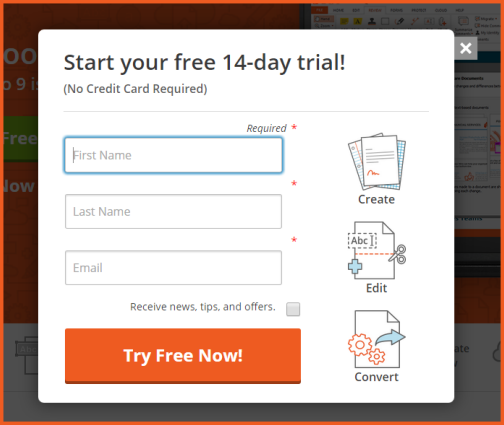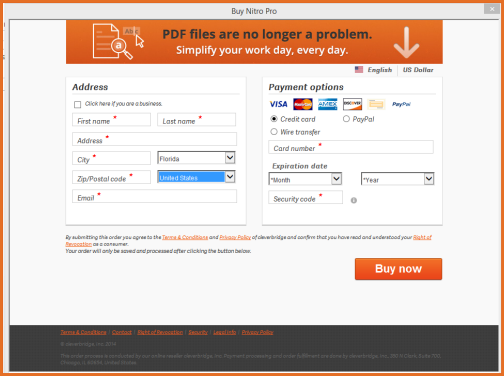by
Erin Hogg, Reporter
Known as the No. 1 alternative to Adobe Acrobat, Nitro offers products used by more than 450,000 businesses around the world to create, share and collaborate on documents.
With the Nitro Pro PDF creation and editing software, the company's goal is to help customers — or what the team calls "prosumers" — improve workplace productivity to grow their business.
"We really want to make sure that the document itself is sort of that living, breathing entity and you can work smart and work directly with it, reducing the time between document creation, document authorization and making it that final form object," said Mike Leyden, Vice President of Growth, Nitro.
Nitro focuses on two target markets: individuals and small teams, and enterprise-level customers.
CHALLENGE
Nitro offers a 14-day fully functional free trial of the Nitro Pro software through its website.
To purchase the software after the free trial concluded, users would have to return to the Nitro website to complete the transaction.
In August 2012, the team was experiencing 250,000 free trials a month but saw drop off points in the trial to conversion process when it came time for the user to decide to purchase.
CAMPAIGN
The team wanted to keep users in the environment of the software, continuing that enjoyment of using Nitro Pro in the customer's mind as they moved through the purchase cycle.
"The real strategy behind in-app purchasing was have a buying experience that not only is it not abrasive; it's seamless from the application they've been enjoying to the purchasing," Leyden said.
This strategy was also aimed at ensuring there was no drop off points between the free trial and the purchasing website, which Leyden described as "a little bit shocking" for the user.
The goal was to make the purchasing experience as easy as possible, without even having to leave the application.
Step #1. Partner with an ecommerce solution
In August 2012, Nitro turned to an ecommerce solution to aid in implementing in-app ordering into the free trials of Nitro Pro. In partnering with an ecommerce provider, the Nitro team would be able to focus more valuable resources on its software product development.
Nitro wanted to accomplish two things with its revamped buying process: make sure customers were not leaving the application experience to transact as well as improve the activation process after the purchase to reduce contact with the Nitro support teams.
"If we reduce contact rates between the customer and Nitro, we knew that we're onto something good here because the activation process with any desktop software can be a little bit funny no matter who you are," Leyden explained.
The activation process was improved through offering a simple button to activate Nitro Pro during the in-app purchase. A serial number is also provided for users who want to activate Nitro products on another machine.
Once partnered, Nitro was able to have its then-current ecommerce data migrated to the new solution and start working to optimize its purchase process.
Step #2. Implement in-app ordering
After establishing the goals for in-app ordering, it was time to implement that functionality into the application.
Nitro aimed to make the free trial process as smooth as possible, from downloading the trial to offering the full version. To activate a free trial, users on the Nitro website must fill out a
short three-field form that will prompt the download to begin.

Click here to see the full version of this creative sample
When users download the free trial of Nitro Pro, the option to purchase the software is directly available on the ribbon bar.
Users can click to "
buy online now" and options are also available to buy multi-user packs and enterprise licensing.
Once a user clicks to purchase, they are presented with pop-up to select the product they'd like to purchase,
including additional cross-sells such as software assurance and a backup CD.
Upon clicking "Checkout," the user remains in the environment to then fill out their billing information, and then are prompted to "
Buy now."

Click here to see the full version of this creative sample
"So with those two objectives in mind, increase conversion and decrease contact rates. We really started to test, and what we did was we looked at the minimum buy flows and really minimalist design aesthetic. And then we built on top of that," Leyden said.
Once a user selects to "Buy now," they are presented with the activation button and serial number to activate Nitro Pro on a different machine.
Step #3. Test checkout elements
In the two years since implementing in-app ordering, Nitro has worked with its vendor to constantly test the checkout process to optimize conversion.
"We would be always running tests of statistical significance, an A/B test of statistical significance at all times, and we would be testing one variable at a time, whether it's the pricing or whether it's messaging," Leyden said.
Nitro has tested various versions of the in-app purchasing process, particularly with
banner messaging and order steps.
In the beginning, the only product available through the in-app ordering process was the single license of Nitro Pro.
However, many customers were also looking to purchase a backup CD of the application as well as software assurance to protect their investment.
Those items were added as cross-sells to the in-app ordering with optimized messaging and placement in the purchase funnel.
The team also realized many of their customers did not want to engage in phone calls for a software purchase of less than $1,000, so multiple license purchases were another option in the in-app ordering as well.
"That was a really enriching experience because it went against some of our initial assumptions, and we really realized that our trial users were very willing to purchase multiple licenses within the application, whereas our previous assumptions that they'd always go to our Web support or alternatively, talk our sales team," Leyden said.
Consider international preferences
Through continual testing and optimization, Nitro noticed there were significantly different purchase paths and preferences by geographic region.
"The great thing about selling online is you get to have the world, you get to have a storefront to the world," Leyden explained.
Compared to customers in the Western hemisphere, the team has found India, Europe and Middle Eastern segments are more conservative in their online purchasing habits.
To combat this challenge, Nitro added an additional confirmation step and more security credibility content to help them feel more secure.
The reasoning behind these differences can possibly be attributed to European purchasing tools, including wire transfers, and the fact that they are looking at it as an international purchase, since Nitro is headquartered in San Francisco.
Once implemented, Nitro saw conversion increases despite the added step for those segments versus North American audiences, which have better conversion coinciding with fewer steps.
"We're actually really trying to modify our experience by region and then, in due course, by country. We've got all the technology in the application to detect who you are and where you are, so we're really trying to use that data to create a very bespoke experience that delights you," he said.
RESULTS
"The primary thrust of this was to make sure that the activation experience was as seamless as possible for our online users, or our 'prosumers,'" Leyden said.
Since implementing in-app ordering, Nitro accounts for 30% of Nitro's overall revenue from that mode of purchasing.
Once cross-sells for CD backups and software assurance were implemented into the buying flow, the team has experienced a 22% increase in cross-sell revenue and a 21% increase in average order value.
Testing and optimizing the checkout process and order steps has also paid off for the company. Nitro achieved an 88% increase in daily conversion and a 380% increase in average app sessions per day for Nitro Pro.
One of the biggest takeaways the Nitro team has learned from this effort is "the best answers come from outside rather than from inside and to really listen to that customer base," Leyden said.
In the future, Nitro is looking to continue leveraging in-app purchases on its Nitro Pro product and will be implementing the sale of Nitro Cloud, a sharing and collaboration service, into the buy process, as well.
Creative Samples
- Free trial download
- Nitro Pro purchase option
- In-app purchasing
- Billing information
- Nitro test variations
Sources
NitroCleverbridgeRelated Resources
Marketing Research Chart: 63% say registration during purchase effective for list buildingPersonalization Marketing: 630% ROI for Portland Trail Blazers via dynamic ticket pricingFunnel Abandonment: Shirtmagic brings 14% of customers back to their website with simple reminder emailCustomer-centric Marketing: Learning from customers helps increase lead quality 130%, Sales-accepted leads 40%










